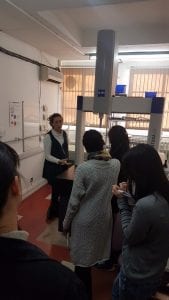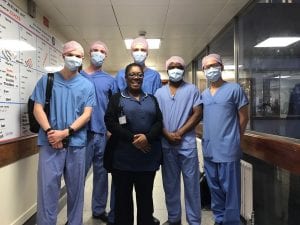Visiting the Stanmore Royal National Orthopaedic Hospital
By rmapapg, on 1 March 2017
by Madeline Lok, Emma Ponting and Sarita Meekul
On Friday 27th of January, our 2nd year Biomedical Engineering class got the opportunity to visit the Stanmore Royal National Orthopaedic Hospital. The purpose of the trip was for us to gain an understanding of how the clinical environment works and how devices we may help to create in the future fit into real people’s lives.
 The day began early with a long journey on the tube to Stanmore, on the outskirts of London where the class met. After a short taxi ride to the hospital, we were met by Professor Hart at the London Implant Retrieval Centre (LIRC). Prof Hart is the director of research and development at LIRC and a consultant orthopaedic surgeon at the hospital. He gave us a warm welcome and introduced us to some of the PhD students working there. At LIRC they recover and study knee and hip replacement implants that have been removed from patients to better understand why they failed. We were shown the processes these implants go through once they arrive, from cleaning to being scanned for wear and deformation and got to hold some actual implants. It was very interesting to see how something that we learn about in lectures actually looks and feels in real life.
The day began early with a long journey on the tube to Stanmore, on the outskirts of London where the class met. After a short taxi ride to the hospital, we were met by Professor Hart at the London Implant Retrieval Centre (LIRC). Prof Hart is the director of research and development at LIRC and a consultant orthopaedic surgeon at the hospital. He gave us a warm welcome and introduced us to some of the PhD students working there. At LIRC they recover and study knee and hip replacement implants that have been removed from patients to better understand why they failed. We were shown the processes these implants go through once they arrive, from cleaning to being scanned for wear and deformation and got to hold some actual implants. It was very interesting to see how something that we learn about in lectures actually looks and feels in real life.
 Then the lovely people of LIRC kindly provided us with lunch with their team. This was a good chance to chat to the people who work in the hospital and get a better insight into the kind of jobs available that we might be interested in once we graduate.
Then the lovely people of LIRC kindly provided us with lunch with their team. This was a good chance to chat to the people who work in the hospital and get a better insight into the kind of jobs available that we might be interested in once we graduate.
After lunch, we were split into smaller groups; some went to watch the surgeries while other went to sit-in with the doctors and their patients for real consultations. We swapped after 1.5 hours.
We were brought to the surgery area to be able to see a real operation taking place. Before entering the operation theatres, we changed into scrubs. We were then separated into pairs and entered different theatres. Among all of us, we saw a range of operations including hip replacements, knee replacements and one ankle-foot correction surgery. We were told that the ankle-foot surgery is one of the most complicated and delicate procedures. The doctor that took us in even made a joke about how he avoided it. They used x-rays during that operation so we had to wear a lead apron to protect ourselves from the radiation. Some others of us saw the removal of implants, which was completely opposite of what the others saw. It was interesting to be able to discuss our different experiences at the end of the day when everyone was together.
Within the operating theatre, the surgeons explained to us what and how they were performing this surgery. Most of us were surprised by the atmosphere in the operating room. It was very relaxed with music playing in the background. The anaesthetist was reading his Kindle; the surgeons were even able to have a conversation and joke about their family while operating on the patient. It was surprising to see how calm and confident they were. Due to the time constraints, none of us were in there for the whole process which was a pity because we all really enjoyed it.
 The consultation sessions were an eye-opening experience too. We had the opportunity to sit through a few consultations with an orthopaedic specialist doctor, and see how they interact with their patients. All patients had very different reasons to be there, so we got to see various cases, the medical images used, and procedure followed. After sitting through the consultations, we now have a better understanding of what doctors go through when seeing patients and it definitely is a very difficult job. It’s not all smiles, hellos, reassurance and prescribing treatments as some people would think. In reality, they are potentially the ones who would be telling you how you would live out the next 10-20 years of your life (in our case, with hip/knee replacements, constant rehab, medication and so on). They have to always maintain professionalism and courtesy no matter how their patients react to whatever they tell them; even answer questions about their other concerns whether or not it is related to the real reason they came in for the consultation in the first place. The most important take-away I had from the session was that the doctors should let the patients leave with the best reassurance they can provide.
The consultation sessions were an eye-opening experience too. We had the opportunity to sit through a few consultations with an orthopaedic specialist doctor, and see how they interact with their patients. All patients had very different reasons to be there, so we got to see various cases, the medical images used, and procedure followed. After sitting through the consultations, we now have a better understanding of what doctors go through when seeing patients and it definitely is a very difficult job. It’s not all smiles, hellos, reassurance and prescribing treatments as some people would think. In reality, they are potentially the ones who would be telling you how you would live out the next 10-20 years of your life (in our case, with hip/knee replacements, constant rehab, medication and so on). They have to always maintain professionalism and courtesy no matter how their patients react to whatever they tell them; even answer questions about their other concerns whether or not it is related to the real reason they came in for the consultation in the first place. The most important take-away I had from the session was that the doctors should let the patients leave with the best reassurance they can provide.
We all had a great day and learnt a lot about working in a clinical setting and working with patients. We would like to say a massive thank you to a ll of the people at Stanmore hospital who helped in making this day happen! What a day and what an experience!
 Close
Close


